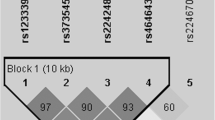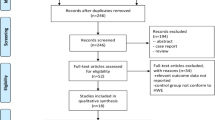Abstract
The association of CYP19 gene polymorphisms with breast cancer has been widely reported, but results of previous studies were somewhat contradictory and underpowered. In order to overcome the limitations of individual study and to understand the real situation, we conducted a systematic review and meta-analysis including three CYP19 gene polymorphisms [R264C polymorphism, CYP19_630 3-bp del/Ins polymorphism, and CYP19_681 (TTTA)n polymorphisms]. A total of 22 studies with 10,592 cases and 11,720 controls were identified, and the results showed that R264C polymorphism was not associated with breast cancer risk in overall (T vs. C: OR = 1.061, 95% CI = 0.929–1.212) or race-based populations (T vs. C for Asian: OR = 1.169, 95% CI = 1.002–1.363; for Caucasian: OR = 0.787, 95% CI = 0.597–1.037); meanwhile, for Asian individuals, 3-bpDel/Ins polymorphism showed a significantly association with breast cancer susceptibility (for allele Del vs. allele Ins: OR = 1.278, 95% CI = 1.066–1.532) while the carriers of allele (TTTA)12 can significantly decrease breast cancer risk (OR = 0.752, 95% CI = 0.603–0.939). Furthermore, the carriers of allele (TTTA)10 were significantly associated with breast cancer susceptibility (OR = 1.515, 95% CI = 1.115–2.058). It can be concluded that potentially functional CYP19_630 3-bp del/Ins polymorphism and CYP19_681 (TTTA)n polymorphisms may play a low penetrance role in breast cancer susceptibility in an ethnicity-specific manner.

Similar content being viewed by others
References
Simpson ER, Clyne C, Rubin G, Boon WC, Robertson K, Britt K, Speed C, Jones M (2002) Aromatase—a brief overview. Annu Rev Physiol 64:93–127. doi:10.1146/annurev.physiol.64.081601.14270364/1/93
Zumoff B (1998) Does postmenopausal estrogen administration increase the risk of breast cancer? Contributions of animal, biochemical, and clinical investigative studies to a resolution of the controversy. Proc Soc Exp Biol Med 217:30–37
Jongen VH, Hollema H, Van Der Zee AG, Heineman MJ (2006) Aromatase in the context of breast and endometrial cancer. A review. Minerva Endocrinol 31:47–60
Stroup DF, Berlin JA, Morton SC, Olkin I, Williamson GD, Rennie D, Moher D, Becker BJ, Sipe TA, Thacker SB (2000) Meta-analysis of observational studies in epidemiology: a proposal for reporting. Meta-analysis of Observational Studies in Epidemiology (MOOSE) group. JAMA 283:2008–2012. doi:jst00003
Little J, Bradley L, Bray MS, Clyne M, Dorman J, Ellsworth DL, Hanson J, Khoury M, Lau J, O’Brien TR, Rothman N, Stroup D, Taioli E, Thomas D, Vainio H, Wacholder S, Weinberg C (2002) Reporting, appraising, and integrating data on genotype prevalence and gene-disease associations. Am J Epidemiol 156:300–310
Mantel N, Haenszel W (1959) Statistical aspects of the analysis of data from retrospective studies of disease. J Natl Cancer Inst 22:719–748
DerSimonian R, Kacker R (2007) Random-effects model for meta-analysis of clinical trials: an update. Contemp Clin Trials 28:105–114. doi:S1551-7144(06)00048-6
DerSimonian R, Laird N (1986) Meta-analysis in clinical trials. Control Clin Trials 7:177–188. doi:0197-2456(86)90046-2
Sangrajrang S, Sato Y, Sakamoto H, Ohnami S, Laird NM, Khuhaprema T, Brennan P, Boffetta P, Yoshida T (2009) Genetic polymorphisms of estrogen metabolizing enzyme and breast cancer risk in Thai women. Int J Cancer 125:837–843. doi:10.1002/ijc.24434
Gulyaeva LF, Mikhailova ON, PustyInyak VO, Kim IV 4th, Gerasimov AV, Krasilnikov SE, Filipenko ML, Pechkovsky EV (2008) Comparative analysis of SNP in estrogen-metabolizing enzymes for ovarian, endometrial, and breast cancers in Novosibirsk, Russia. Adv Exp Med Biol 617:359–366. doi:10.1007/978-0-387-69080-3_34
Hu Z, Song CG, Lu JS, Luo JM, Shen ZZ, Huang W, Shao ZM (2007) A multigenic study on breast cancer risk associated with genetic polymorphisms of ER Alpha, COMT and CYP19 gene in BRCA1/BRCA2 negative Shanghai women with early onset breast cancer or affected relatives. J Cancer Res Clin Oncol 133:969–978. doi:10.1007/s00432-007-0244-7
Justenhoven C, Hamann U, Schubert F, Zapatka M, Pierl CB, Rabstein S, Selinski S, Mueller T, Ickstadt K, Gilbert M, Ko YD, Baisch C, Pesch B, Harth V, Bolt HM, Vollmert C, Illig T, Eils R, Dippon J, Brauch H (2008) Breast cancer: a candidate gene approach across the estrogen metabolic pathway. Breast Cancer Res Treat 108:137–149. doi:10.1007/s10549-007-9586-8
Song C, Hu Z, Yuan W, Di G, Shen Z, Huang W, Shao Z (2006) Effect of R264C polymorphism in CYP19A1 gene on BRCA1/2-negative hereditary breast cancer from Shanghai population of China. Chin J Med Genet 23:181–183
Hefler LA, Tempfer CB, Grimm C, Lebrecht A, Ulbrich E, Heinze G, Leodolter S, Schneeberger C, Mueller MW, Muendlein A, Koelbl H (2004) Estrogen-metabolizing gene polymorphisms in the assessment of breast carcinoma risk and fibroadenoma risk in Caucasian women. Cancer 101:264–269. doi:10.1002/cncr.20361
Lee KM, Abel J, Ko Y, Harth V, Park WY, Seo JS, Yoo KY, Choi JY, Shin A, Ahn SH, Noh DY, Hirvonen A, Kang D (2003) Genetic polymorphisms of cytochrome P450 19 and 1B1, alcohol use, and breast cancer risk in Korean women. Br J Cancer 88:675–678. doi:10.1038/sj.bjc.66007616600761
Miyoshi Y, Iwao K, Ikeda N, Egawa C, Noguchi S (2000) Breast cancer risk associated with polymorphism in CYP19 in Japanese women. Int J Cancer 89:325–328. doi:10.1002/1097-0215(20000720)89:4<325:AID-IJC2>3.0.CO;2-3
Ribeiro FS, de Amorim LM, de Almeida Simao T, Mendonca GA, de Moura Gallo CV, Pinto LF (2006) CYP19 (TTTA)n polymorphism and breast cancer risk in Brazilian women. Toxicol Lett 164:90–95. doi:S0378-4274(05)00403-0
Han DF, Zhou X, Hu MB, Xie W, Mao ZF, Chen DE, Liu F, Zheng F (2005) Polymorphisms of estrogen-metabolizing genes and breast cancer risk: a multigenic study. Chin Med J (Engl) 118:1507–1516
Dialyna I, Tzanakakis G, Dolapsakis G, Tsatsakis A (2004) A tetranucleotide repeat polymorphism in the CYP19 gene and breast cancer susceptibility in a Greek population exposed and not exposed to pesticides. Toxicol Lett 151:267–271. doi:10.1016/j.toxlet.2004.01.024S0378427404000840
Baxter SW, Choong DY, Eccles DM, Campbell IG (2001) Polymorphic variation in CYP19 and the risk of breast cancer. Carcinogenesis 22:347–349
Healey CS, Dunning AM, Durocher F, Teare D, Pharoah PD, Luben RN, Easton DF, Ponder BA (2000) Polymorphisms in the human aromatase cytochrome P450 gene (CYP19) and breast cancer risk. Carcinogenesis 21:189–193
Xie W, Feng M, Wang F, Chen J, Cheng T, Hu M, Li C, Zhou Y (2008) Single nucleotide polymorphism of estrogen metabolizing genes CYP17, CYP19 and breast cancer susceptibility. Chin J Gen Surg 23:540–543
Kristensen VN, Andersen TI, Lindblom A, Erikstein B, Magnus P, Borresen-Dale AL (1998) A rare CYP19 (aromatase) variant may increase the risk of breast cancer. Pharmacogenetics 8:43–48
Probst-Hensch NM, Ingles SA, Diep AT, Haile RW, Stanczyk FZ, Kolonel LN, Henderson BE (1999) Aromatase and breast cancer susceptibility. Endocr Relat Cancer 6:165–173
Haiman CA, Hankinson SE, Spiegelman D, De Vivo I, Colditz GA, Willett WC, Speizer FE, Hunter DJ (2000) A tetranucleotide repeat polymorphism in CYP19 and breast cancer risk. Int J Cancer 87:204–210. doi:10.1002/1097-0215(20000715)87:2<204:AID-IJC8>3.0.CO;2-3
Suspitsin EN, Grigoriev MY, Togo AV, Kuligina ES, Belogubova EV, Pozharisski KM, Chagunava OL, Sokolov EP, Theillet C, Berstein LM, Hanson KP, Imyanitov EN (2002) Distinct prevalence of the CYP19 Delta3(TTTA)(7) allele in premenopausal versus postmenopausal breast cancer patients, but not in control individuals. Eur J Cancer 38:1911–1916. doi:S0959804902001491
Siegelmann-Danieli N, Buetow KH (1999) Constitutional genetic variation at the human aromatase gene (Cyp19) and breast cancer risk. Br J Cancer 79:456–463. doi:10.1038/sj.bjc.6690071
Thyagarajan B, Brott M, Mink P, Folsom AR, Anderson KE, Oetting WS, Gross M (2004) CYP1B1 and CYP19 gene polymorphisms and breast cancer incidence: no association in the ARIC study. Cancer Lett 207:183–189. doi:10.1016/j.canlet.2003.12.009S0304383503008504
Olson JE, Ingle JN, Ma CX, Pelleymounter LL, Schaid DJ, Pankratz VS, Vierkant RA, Fredericksen ZS, Wu Y, Couch FJ, Vachon CM, Sellers TA, Weinshilboum RM (2007) A comprehensive examination of CYP19 variation and risk of breast cancer using two haplotype-tagging approaches. Breast Cancer Res Treat 102:237–247. doi:10.1007/s10549-006-9324-7
American Cancer Society (2009) Estimated new cancer cases and deaths for 2009. http://seer.cancer.gov/csr/1975_2006/results_single/sect_01_table.01.pdf
Watanabe J, Harada N, Suemasu K, Higashi Y, Gotoh O, Kawajiri K (1997) Arginine-cysteine polymorphism at codon 264 of the human CYP19 gene does not affect aromatase activity. Pharmacogenetics 7:419–424
Acknowledgement
This work was not supported by any funds.
Author information
Authors and Affiliations
Corresponding authors
Additional information
The first two authors have contributed equally to this article.
Rights and permissions
About this article
Cite this article
Ma, X., Qi, X., Chen, C. et al. Association between CYP19 polymorphisms and breast cancer risk: results from 10,592 cases and 11,720 controls. Breast Cancer Res Treat 122, 495–501 (2010). https://doi.org/10.1007/s10549-009-0693-6
Received:
Accepted:
Published:
Issue Date:
DOI: https://doi.org/10.1007/s10549-009-0693-6




